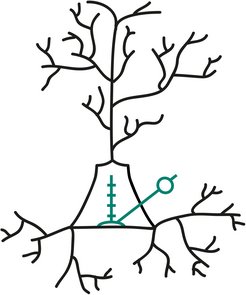Neurons with good timing
A new class of neurons aids communication in the visual system
Whatever we perceive, feel or do, is accomplished through communication between neurons in the brain. Just like in human communication, effective neural communication depends on listening to each other at just the right time. Researchers at the Ernst Strüngmann Institute for Neuroscience in Frankfurt have discovered a new type of cell that might aid precise information transmission by providing the right timing.

Ever since the beginning of brain research, scientists have tried to infer the functions of the neural system from its building blocks: single nerve cells, or “neurons”. Neurons use sudden, electric discharges to transmit information. These so called action potentials or “spikes” are, so to say, the language of the brain. By sorting spikes according to shape and signal-strength, individual neuron “voices” can be identified in isolation from a choir of active neurons. In this way, neurons can be divided into groups of cells with similar characteristics, so called functional cell classes. In the primary visual cortex, which is the first brain area that process things we see, neurons fall in two different classes: inhibitory neurons with fast, narrowly shaped spikes, which silence the activity of other cells, and excitatory neurons with slower, more broadly shaped spikes, which enhance the activity of other cells.
While this categorisation may be a good rule of thumb, a recent finding shows that notable exceptions exist: “Looking at the spiking activity from neurons in the primary visual cortex, we identified a third class of cells that was previously unknown,” says Irene Onorato, first author of the study. The researchers discovered the newly described cell type in two different kinds of monkeys, but not in mice.
The new type of cells are characterized by properties which in part resemble inhibitory neurons: they have fast, narrow shaped spikes. Yet, their activity patterns are clearly distinct from those of inhibitory neurons, namely, they break into burst-like bouts of spiking activity. Moreover they seem to be excitatory. Looking at the ratio of cell types, the researchers found that almost a third of the recorded neurons fell in the narrow-spike, bursting class. A fraction that is surprisingly large for a cell-type that has until now been overlooked.

Martin Vinck who supervised the study sees one possible explanation in the choice of animal model. “There are very few studies that have looked into functional cell classes in the primate brain. Most studies of that kind are done in mice. And as we could show by comparing data between species, mice simply don’t have these neurons.” Currently, mice are the most popular model organism in neuro science and with good reason. There are many cutting edge techniques, particularly genetic tools that can be used in mice but not in monkeys. This advantage however is compromised by the less developed cognitive abilities of the small rodents. Considering the differences between species, it’s no surprise to the researchers to also find differences in their brains. One of the striking differences between brains of monkeys and mice is that in monkey visual cortex there is a lot of rhythmic network activity.
By contrast, in the visual cortex of mice, the rhythmic activity is much weaker. Brain rhythms, also called oscillations, reflect the synchronized activity of many neurons at the same time. Neuroscientists suspect oscillations to have a major impact on neural communication and memory formation. Particularly synchronized activity in the so called gamma band between 30 and 80 Hertz is thought to play a role in higher cognitive functions, like attention and predictive processing.
Good timing, good communication

“Knowing that particularly the monkey visual cortex basically flows over with rhythmic activity, and then discovering a type of neuron, like ours with its burst of rhythmic activity, again in monkeys but not mice, it is kind of obvious to suspect a connection,” thinks Martin Vinck. He and his colleagues developed mathematical tools in order to investigate of the exact relationship between neurons and brain waves.
Indeed, the data analyses suggest that the newly described neurons, through interactions with inhibitory neurons, may act as a pacemaker to produce gamma-waves. Previous research has shown that when spikes are synchronized in gamma waves, they are transmitted more effectively to higher brain areas. It is as-if synchronized activity provides a schedule for neurons at what time to speak up in order to be heard well. The new cell-type seems to act as a director for this schedule. It gets the timing right. Accordingly, it seems very probably that the new cell-type could transmit its information in a more powerful and efficient way to distant neuronal populations. These cells could therefore be very important for visual processing.














